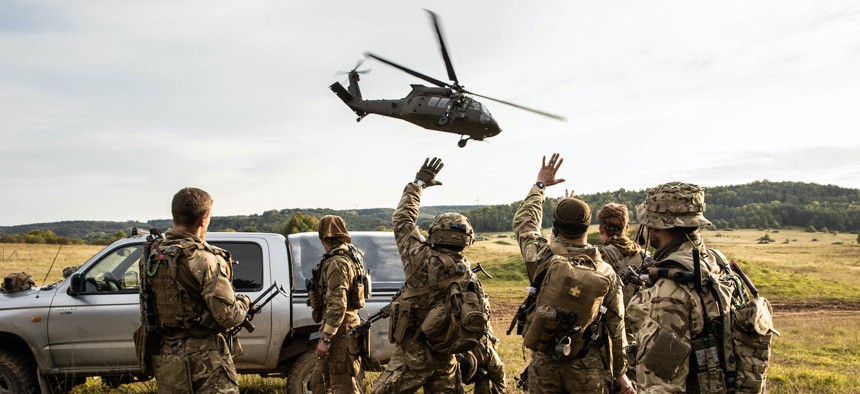
In this 2020 photo, Ukrainian special forces wave to their pilots from the 101st Combat Air Brigade after a flight mission during Exercise Combined Resolve 14 at Hohenfels, Germany. U.S. Army / Sgt. Patrik Orcutt
At Army’s special-ops school, the biggest changes in a generation
Ukraine, robotics, and more are driving a six-year plan to improve training in irregular warfare, technology, and psyops.
FORT LIBERTY, North Carolina—Clustered around a table in a classroom festooned with Ukrainian-language posters, six Army special operations soldiers chatted in Ukrainian with a visitor this month—not without hesitation, but seemingly ready for their upcoming exams.
“I'm very proud of them; they're doing very well,” said a Ukrainian instructor at the Army’s John F. Kennedy Special Warfare Center and School.
The six-month course is among a slew of Ukraine-related changes at the school—and part of Army Special Operations Forces’ broader, six-year plan to revamp instruction in irregular warfare, technology, and psychological operations.
Students in the Ukraine class are the guinea pigs for a course that didn’t even exist until October. The course was designed from scratch over nine months, the Ukrainian instructor said, vastly condensing a process that typically takes three to five years.
Upon graduation, students will speak Ukrainian at a 1+ level on the Interagency Language Roundtable scale, a government-defined criteria that corresponds to elementary proficiency. The class aims to teach soldiers to bargain, exchange basic data on weapons, and establish rapport with Ukrainian soldiers who they might train.
The schoolhouse is also revamping basic-skills education to reflect lessons from Ukraine, according to Brig. Gen. Guillaume Beaurpere, chief of the Special Warfare Center and School.
Engineer sergeants must now learn how to both build and defeat tank ditches, a defensive feature that stymied Ukraine’s summer counter-offensive.
Drones have also been incorporated into Robin Sage, the comprehensive test that ARSOF soldiers must pass to graduate from the Special Warfare School; as well, weapons sergeants have renewed training with Stinger anti-aircraft missiles, a reflection of the contested skies over Ukraine.
“You talk to any soldier in Ukraine: you don't go anywhere without a drone flying, either in support of you or against you,” said Beaurpere.
Training for ARSOF medics also now emphasizes that they can no longer depend on speedy medical evacuation. “Austere medicine is really coming back to our program,” said Beaurpere.
2030 plan
Bigger changes, not necessarily influenced by Ukraine, are also in the works to centralize instruction in the school’s core competencies — irregular warfare, psychological warfare, and civil affairs — by 2030. The changes will create distinct sub-schools, in a process akin to establishing faculty offices at a university.
By 2027, the school will host a new irregular warfare academy, which will teach the type of behind-the-lines combat that Army special operations forces have long trained in. One of the first steps, updating the Army’s irregular warfare doctrine, is already in the works with an anticipated release date for the new doctrine sometime in 2026.
“One chapter has been written and there is a logic map that's out there being circulated in terms of the rest of the content,” said Beaurpere.
In the meantime, he said, his command will issue training guidance in the next six to 12 months that will preview the doctrine changes.
“We're going to start with something that is very tactical, that can get out to the force very quickly,” he said.
Beaurpere said doctrine would focus in part on disrupting an adversary’s strategy, such as by pre-positioning troops in countries that an enemy might attack or positioning them in friendly countries near an adversary.
Other focuses for special operations forces include using them to provide access to enemy intelligence, potentially in partnership with other commands. ARSOF can provide “proximal access to areas that are of potential strategic interest to [Cyber Command] or [Space Command],” Beaurpere said.
Beaurpere also said the irregular warfare school may include new efforts to integrate electronic warfare and signals intelligence training. “We envision a pretty prolonged program of instruction that probably would run several months,” he said.
Psychological operations and civil affairs instruction will also get their own branch schools under the redesign, according to schoolhouse plans. One key change is appointing commandants for each branch school house, who can use their authority to drive modernization. The Army has designated a commandant for the psychological warfare branch from the reserve, Beaurpere said.
Beaurpere is also pushing to move the New York-based brigade that trains soldiers in psychological operations to Fort Liberty, although no decision has been made yet. “The next step to the [psychological warfare] school is a total Army school, one that looks at the reserves and the active component,” he said.
A Defense Department Inspector General report released in March said that the Army frequently had to rely on reservists due to a lack of trained active-duty psychological warfare soldiers.
In a nod to the increasing use of drones and other robotic systems in Ukraine and elsewhere, the Special Warfare School has also launched the Robotics and Unmanned Systems Integration course in October 2023. The six-week program will train 25 students four times a year on operating drones and advising partner forces on their use.
ARSOF also plans to launch a military occupational speciality focused on robotics, according to a press officer.
“We are working with the Army to create this MOS, which will fill a need in ARSOF as well as inform how the Army could approach this on a larger scale,” the press officer said.




